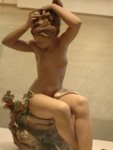Check this out ... an article from the
NPR
Painful Memories for China's Footbinding Survivors
by Louisa Lim
Zhou Guizhen, 86, says she regrets binding her feet.
"But at the time, if you didn't bind your feet,
no one would marry you," she says.
Wang Lifen no longer remembers the pain of breaking her bones,
but admits that sometimes her feet still hurt so much
she can't even put them down on the ground.
Suffering for beauty is a concept familiar to most women, who have dyed, plucked or shaved their hair, squeezed their feet into uncomfortable high heels or even surgically enhanced parts of their anatomy. Millions of Chinese women went even further — binding their feet to turn them into the prized "three-inch golden lotuses."
Footbinding was first banned in 1912, but some continued binding their feet in secret. Some of the last survivors of this barbaric practice are still living in Liuyicun, a village in Southern China's Yunnan province.
Wang Lifen was just 7 years old when her mother started binding her feet: breaking her toes and binding them underneath the sole of the foot with bandages. After her mother died, Wang carried on, breaking the arch of her own foot to force her toes and heel ever closer. Now 79, Wang no longer remembers the pain.
'Young Bones Are Soft'
"Because I bound my own feet, I could manipulate them more gently until the bones were broken. Young bones are soft, and break more easily," she says.
At that time, bound feet were a status symbol, the only way for a woman to marry into money. In Wang's case, her in-laws had demanded the matchmaker find their son a wife with tiny feet. It was only after the wedding, when she finally met her husband for the first time, that she discovered he was an opium addict. With a life encompassing bound feet and an opium-addict husband, she's a remnant from another age. That's how author Yang Yang, who's written a book about them, sees these women.
"These women were shunned by two eras," Yang says. "When they were young, footbinding was already forbidden, so they bound their feet in secret. When the Communist era came, production methods changed. They had to do farming work, and again they were shunned."
A Dwindling Few
Outside the temple in Liuyicun, old women sit chatting, some resting their shrunken feet in the sunlight. Seven years ago, there were still 300 women with bound feet in this village. But many have since died. The village's former prosperity, from its thriving textile business, was the reason every family bound their daughters' feet. And they carried on long after footbinding was outlawed in 1912.
Zhou Guizhen remembers tricking the government inspectors.
"When people came to inspect our feet, my mother bandaged my feet, then put big shoes on them," Zhou says. "When the inspectors came, we fooled them into thinking I had big feet."
Zhou is now a fragile 86-year-old with a rueful chuckle. Tottering along in her blue silk shoes embroidered with phoenixes, she marvels at how the world has changed. Born into a rich family and married into fabulous wealth, all her possessions were confiscated by the Communists.
A Regretful Decision
Now she opens the door to her dark, decrepit one-room hut with earthen floors and paper-lattice windows through which the cold wind whistles. Values have been turned upside down since her childhood. Then, she says, bound feet were seen as a mark of class. Now, they stand for female subjugation.
"I regret binding my feet," Zhou says. "I can't dance, I can't move properly. I regret it a lot. But at the time, if you didn't bind your feet, no one would marry you."
These "golden lotuses" were proof of a foot fetish on a national scale, with hobbled feet acting as another erogenous zone, the most forbidden of them all. But for author Yang Yang, whose mother had bound feet, the reality was far more prosaic.
"The bandages that women used for footbinding were about 10 feet long, so it was difficult for them to wash their feet," Yang says. "They only washed once every two weeks, so it was very, very stinky. But when I was young I was very free, because when I was naughty my mother couldn't run fast enough with her bound feet to catch me and beat me."
Despite their self-inflicted disabilities, these women are survivors. Wang often baby-sits her neighbors' toddler, carrying the plump 20-pound child on her back as she goes about her daily chores. As Wang surveys her tiny shoes, cocking her head from side to side, it's clear she's proud of her little feet.
Lingering Pride
"There's not a single other woman in Liuyicun who could fit their feet into my shoes," she says. "When my generation dies, people won't be able to see bound feet, even if they want to."
These women even gained fame of a sort, forming a bound-feet disco dancing troupe which toured the region. Zhou was once the star of the troupe, but now she's too old to dance.
Such public display is a far cry from their youth, when their bound feet restricted their freedom, keeping them close to their homes. But the local press criticized the dance troupe, talking of exploitation and freak shows. These women yet again are victims of history in a society that finds their plight an embarrassing reminder of its own recent brutality towards women.
Wealthy Chinese women with bound feet
pose for a photo, circa 1900-1920.











